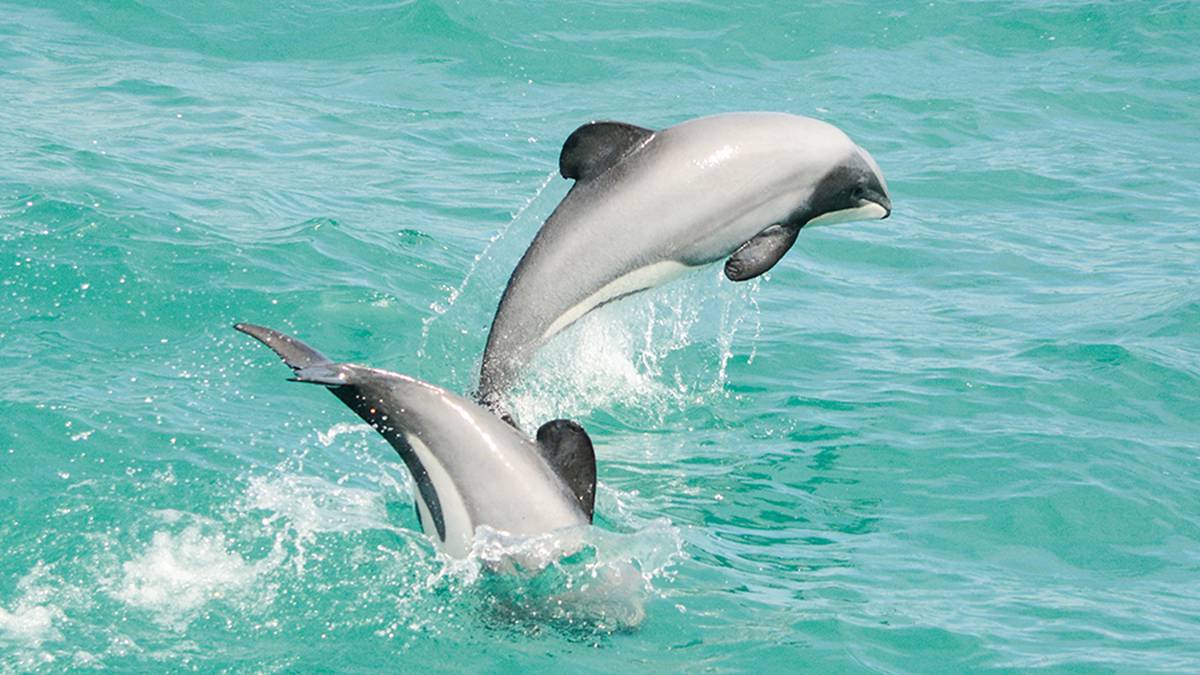Hector’s dolphins in Akaroa Harbour. Photo / Supplied
A solitary Hector’s dolphin has been spotted in Whangārei waters more than 1000km away from its usual home.
The Department of Conservation (DoC) is asking Northlanders to report any sightings of the vulnerable dolphins after
the odd trip north from the South Island’s inshore waters.
DoC Marine Technical Advisor Kristina Hillock said the Hector’s dolphin – distinguishable by its rounded fin – was first spotted by a member of the public in Auckland’s Mahurangi Harbour on September 2.
Potentially the same dolphin has then ventured into Northland waters as two sightings reportedly occurred in Whangārei near Onerahi Beach on September 4 and 5.
Hillock said the Hector’s dolphin was then seen swimming up the far end of the Hātea River on September 6.
“It’s very unusual to see Hector’s dolphins this far north on the east coast of the North Island.”
Marine mammal expert and former University of Otago zoology department professor, Liz Slooten, said sightings outside of the South Island happen once every couple of years.
/cloudfront-ap-southeast-2.images.arcpublishing.com/nzme/DG7X56QXFPBK36XEQT5424DP7Q.jpg)
Hector’s dolphins are usually found in sub-populations between the Marlborough Sounds and Otago peninsula; Jackson Bay to Kahurangi Point; along the south coast between Toetoes and Porpoise Bays, and in Te Waewae Bay.
“Exceptions are individuals that reach maturity, especially males, and they go on a runner looking for mates in different parts of the country,” Slooten said.
The Bay of Islands potentially hosted some of these “adventurous Christopher Columbus” Hector’s dolphins nearly a decade ago.
But there’s a chance they may have been the “nationally critical” Māui dolphins which live only on the west coast of the North Island from Maunganui Bluff to Whanganui.
The only way to tell the two apart is via genetic testing as both have distinctive grey, white and black markings. Their snouts are a different shape, with no obvious beak and they have a rounded fin.
But that didn’t stop an enthusiastic recount of two encounters had by Former Fullers deckhand and nature guide Joanne ‘Floppy’ Halliday in the Bay of Islands five to eight years ago.
The first, said Halliday – who co-founded Whale Rescue alongside Ingrid Visser, was when “one little” Hector’s or Māui dolphin came into the bay known as “middle ground”.
“[…]because he was on his own he was a little bit iffy about spending too much time near anybody.”
Two years later while out on the water she spotted a pod of four to five Hector’s or Māui that appeared near Taylor Island in Paihia.
They milled around Russell, Paihia and Waitangi before heading south.
The encounters “left a wonderment” in Halliday who had seen “all sorts” during her 30-year career working on boats where Bottlenose dolphins were more familiar.
Slooten said visiting Hector’s may choose to stay depending on what they find on their new horizons.
“For example, if they find good conditions they may move there.”
Slooten said North Island waters – especially the Hauraki Gulf – are prime for Hector’s dolphins, so much so they used to be part of their roaming ground.
“The fact they aren’t here now in many places isn’t because they don’t like it but it’s because they’ve been wiped out. The habitat is perfectly suitable.”
/cloudfront-ap-southeast-2.images.arcpublishing.com/nzme/3P5W2QUQG2ZB24OOEAKUOTL6H4.jpg)
Slooten said fishing, trawling, and gillnets – vertical panels of netting that hang from a line – around the 1970s were key factors in Hector’s decline from around roughly 50,000 at one point to 15,000 today.
“Maybe what is happening with these [Hector’s] dolphins is they are rescuing the North Island population,” she said.
DoC hopes any reported sightings might allow staff to get close enough to take a small skin sample from the dolphin.
The skin sample would provide genetic information that would help determine which sub-species and population the animal has come from.
Hillock said people should report the date and time of the sighting, GPS co-ordinates – if available – time spent near the dolphins, direction of their travel, location descriptions and the dolphins’ activity.
“Photographs and video are very helpful for us as well – it helps us confirm the dolphin species, and to look for identifying marks on individuals.”
People can report sightings by calling the DoC emergency hotline – 0800 DOC HOT (0800 362 468) – or via email: marine@doc.govt.nz




